МОДЕЛИРОВАНИЕ И УПРАВЛЕНИЕ ПРОЦЕССАМИ ОКИСЛЕНИЯ БИТУМОВ В КОЛОННЫХ ОКИСЛИТЕЛЬНЫХ АППАРАТАХ НЕПРЕРЫВНОГО ДЕЙСТВИЯ
Шариков Ю.В.1 Титов О.В.2
1Доктор технических наук, профессор; 2кандидат технических наук, ассистент Национальный минерально-сырьевой университет «Горный»
МОДЕЛИРОВАНИЕ И УПРАВЛЕНИЕ ПРОЦЕССАМИ ОКИСЛЕНИЯ БИТУМОВ В КОЛОННЫХ ОКИСЛИТЕЛЬНЫХ АППАРАТАХ НЕПРЕРЫВНОГО ДЕЙСТВИЯ
Аннотация
Данная работа посвящена исследованию влияния конструктивных особенностей аппарата окисления на качество битумов. Разработана математическая модель процесса окисления битума. На основе предложенной математической модели было проведено моделирование процессов окисления в секционированном аппарате, исследовано влияния числа ячеек, распределения температур по ячейкам и расхода воздуха в различные ячейки.
Ключевые слова: математическая модель; окисление; битум; колонный аппарат.
Sharikov Y.V.1, Titov O.V.2
1Doctor, professor; 2PhD in technical, assistant National mineral resources university (University of mines)
SIMULATION AND CONTROL OF BITUMEN’S OXIDATION PROCESSES IN BUBBLE TOWERS OF CONTINUOUS ACTION
Abstract
It has been researched influence of the oxidation unit design features on the process of tars oxidation for the purpose of stable quality bitumen’s production.
The mathematical model of the oxidation of the tars initiated by air has been constructed. The simulation of processes of oxidation in the partitioned device has been spent. It has been researched influences of number of cells, distributions of temperatures on cells and air expense in various cells.
Keywords: bitumen; bubble tower; oxidation processes.
It is known that quality of bitumen is influenced by basic three factors: structure of raw materials for oxidation, oxidation conditions of and it’s the choice of equipment, and also structure of commodity bitumen. At present there are various methods of tars oxidation process efficiency increasing, in order to obtain reception bitumen’s, in particular, it is a method of increasing of surface of phases contact of with the development of air devices, use dispersers an air. Optimization of the parameters of technological process and raw materials selection also has positive influence. Further more Application of catalysts of oxidation and oxidizers specially entered into system should be mentioned.
The given work is devoted to the research of the influence of oxidation device design on quality of bitumen’s. The research has been focused on the studying of sectioning of the device of oxidation on efficiency, process as well as quality of received products.
You can see oxidizing reactors in the figures.
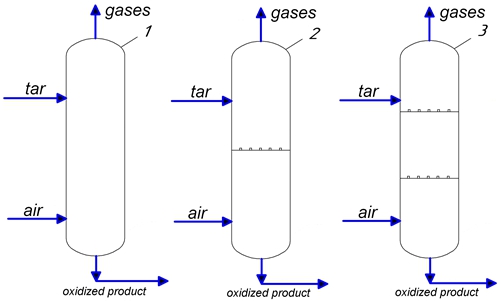
Fig. 1 - Diagrams of the oxidizing tower of the various design.; 1–single-section tower, 2– two-section tower, 3– three-section tower
The columned device as an oxidizer can be divided into sections with the help of special bubble-cap tray. The description of disks is presented below.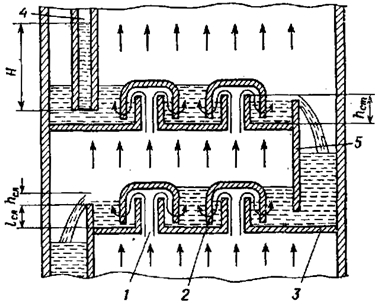
Fig. 2 - Diagram of work of the bubble-cap tray: 1 — nipple; 2 — hood; 3 — disk of the dish; 4— overflow pipe; 5— exhaust partition. H— height of the fluid level in the downcomer; hст— height of the glass; hсл— Height of the static suction head at liquid plum; lсл — height of the downcomer
The bubble-cap tray is a metal disk having a set of apertures for steam pass. There are boards of the certain height, named glasses fixed around apertures. These boards are fixed to keep the certain liquid level. The glasses are covered by a bubble-cap.
There is a gap for the pass of the stream coming from lower disk between top part of the glass and the bubble-cap.
The bubble-caps are plunged into the liquid at work and consequently the hydraulic gate is formed, where steams are passed through.
The liquid level at the disks is supported by drain partitions (tank port). Their bottom part reaches the following disk. The liquid surplus goes down a long tank ports on an under laying disk. The position of bubble-caps may be regulated, changing the gap size between a bubble-cap and the top part of the glass. It is very important, that disks are placed horizontally in the oxidizing tower; further more and all bubble-caps are equally plunged in the liquid at the disk. On the contrary the liquid layer will be thinner in any part of the disk. And as a result more liquid volume can go through this part of the disk.
Consequently the other bubble-caps on the rest of the disk stop working.
The analysis of processes of mass-heat-exchange has allowed studying the influence of various conditions of process carrying out on the characteristics of the end-product. Besides, it has allowed studying internal characteristics of the process. Further the hydrodynamic model of process, as a basis of the mathematical description has been studied. Then kinetics of the oxidation process has been made.
In the second task the influence of oxidation conditions and sectioning of the working zone of the device on the oxygen conversion and the quality of end product has been investigated.
The simulation of oxidation processes has been made with the help of computer program ReactOp Cascade 3.20. Parameters have been calculated.
Besides the conclusions of the research results have been made based on the parameters.
As a result of the work the mathematical model of the oxidation of the tars initiated by air, adequately describing all set of experimentally received dependences has been constructed.
On the basis of the offered mathematical model simulation of oxidation processes in the partitioned device has been made, the influences of the cells number, temperature distributions and air expense in various cells have been tested.
You can see curves charts in the figures.
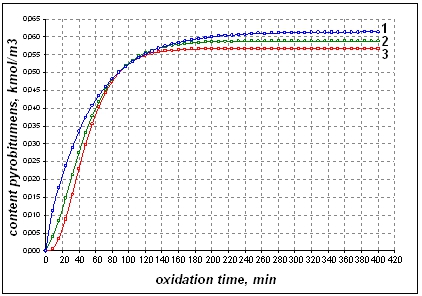
Fig.3 - Kinetic speed performance curve of the changing of the content pyrobitumens at the tars oxidation in the oxidizing tower of a various design; curve №1– single-section tower, №2– two-section tower, №3– three-section tower.
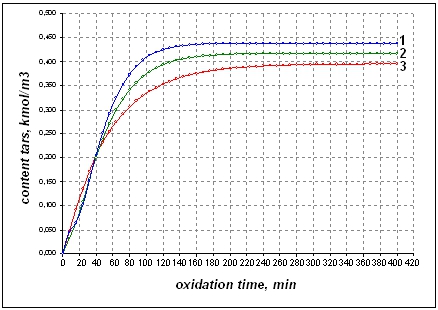
Fig. 4 - Kinetic performance curve of the changing of the content tars at the tars oxidation in the oxidizing tower of a various design; curve №1– single-section tower, №2– two-section tower, №3– three-section tower.
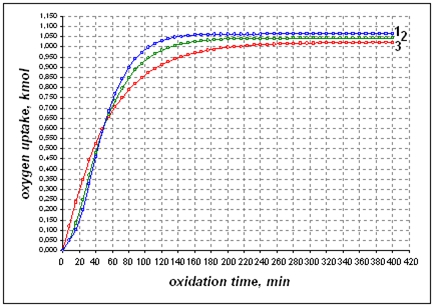
Fig. 5 - Kinetic speed performance curve of the oxygen uptake at the tars oxidation in the oxidizing tower of a various design; curve №1– single-section tower, №2– two-section tower, №3– three-section tower.
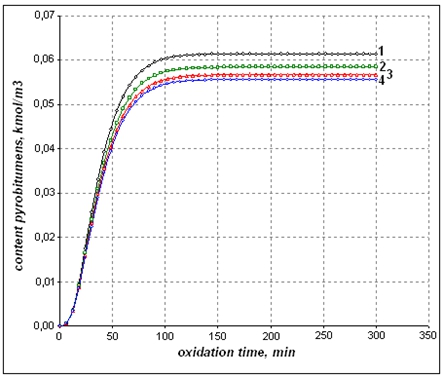
Fig.6 - Kinetic speed performance curve of the changing of the content pyrobitumens at the tars oxidation in the three-section tower; curve №1– temperature 623К, №2– 523К, №3– 423К, №4– 398К.
As a result of our calculations and on the basic of the results of simulation it is possible to confirm:
- Temperature is one of the defining factors influencing for rate of the reaction of oxidation of various groups of hydro carbon components of tar (vast quantity of high-molecular products of oxidation pyrobitumens have been obtained during our research).
- The more temperature is the more intensive high molecular components transformation takes place. Besides consolidation reactions.
Hence, the optimum temperature of oxidation of raw materials will define substantially by the quality of the received bitumen.
- What is more air expense strongly influences on the oxidation process. The expense increase on sections positively affects the conversion pirobytumens. It is possible to draw a conclusion on the basis of kinetic curves of oxygen the efficiency of oxygen use is decreasing. It can be explained by the fact that with the increase of oxidation time the viscosity of raw materials increases, the speed of reactions of consolidation with formation pirobytumens from pitches decreases.
It also should be started that idea. Results of simulation of sectioning of hollow towers for the purpose of the processes of tars oxidation intensification are confirmed. Sectioning of columned hollow unit is a perspective direction which can be realized at the current bitumen plants.
References
- Эрих В. Н., Расина М. Г., Рудин М. Г. Химия и технология нефти и газа. М.:«Химия», 1972.
- Иванова Л. В., Корнеев М. И., Юзбашев В. Н. Технология переработки нефти и газа. М.: «Химия», 1986.
